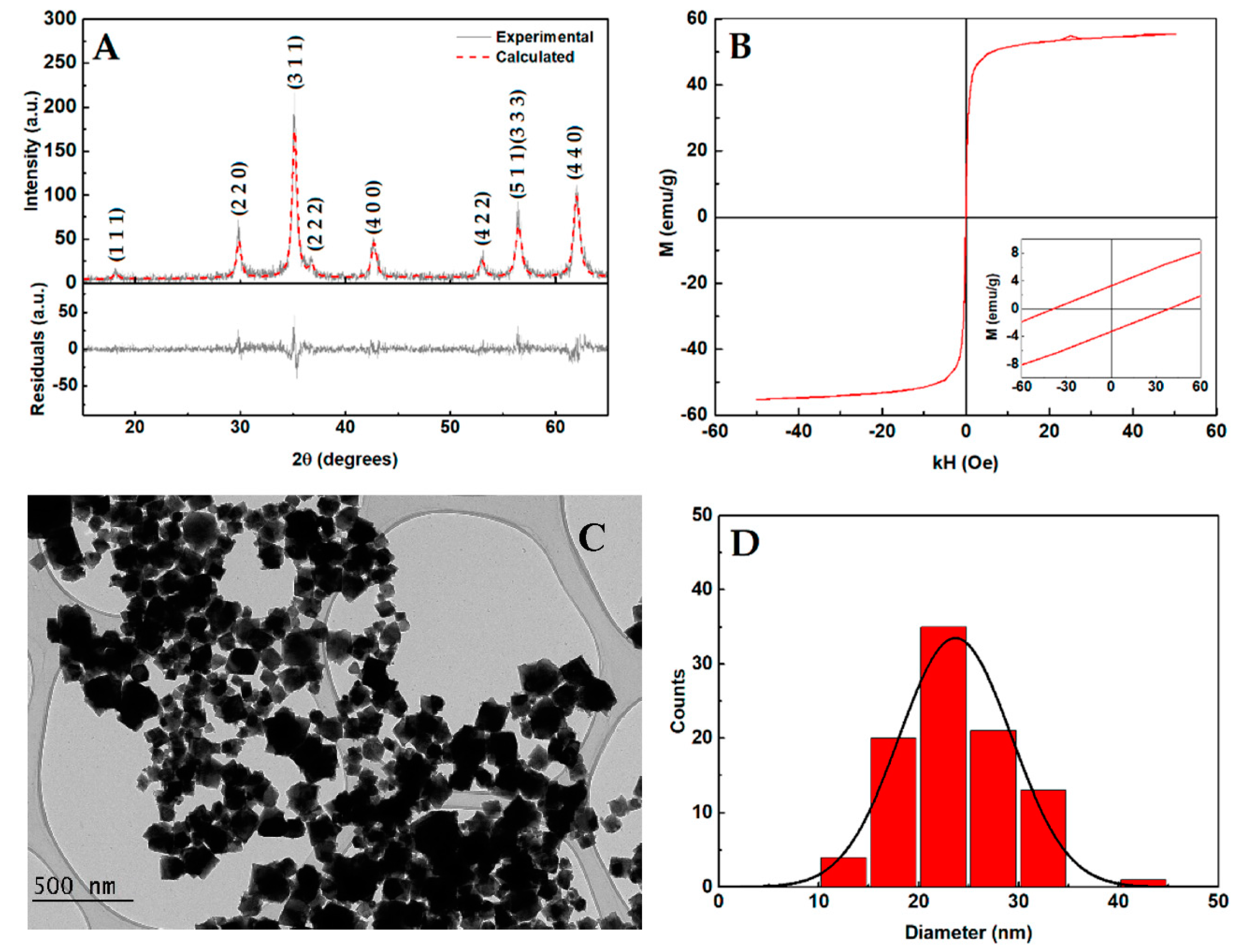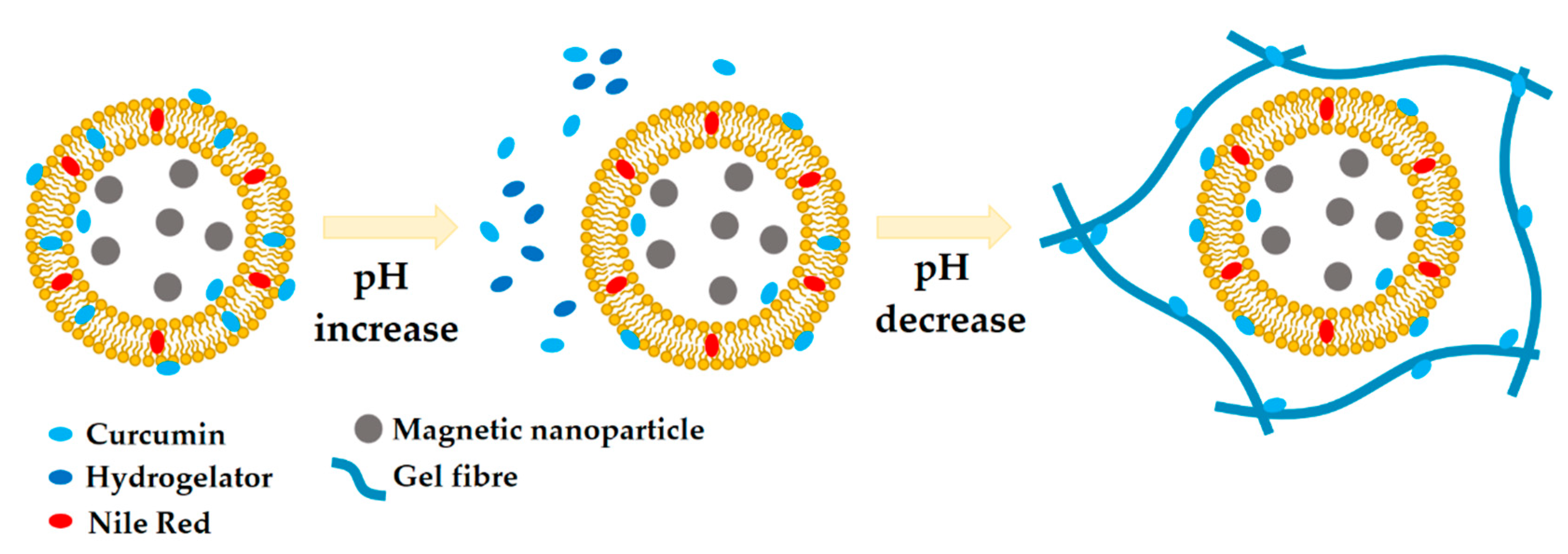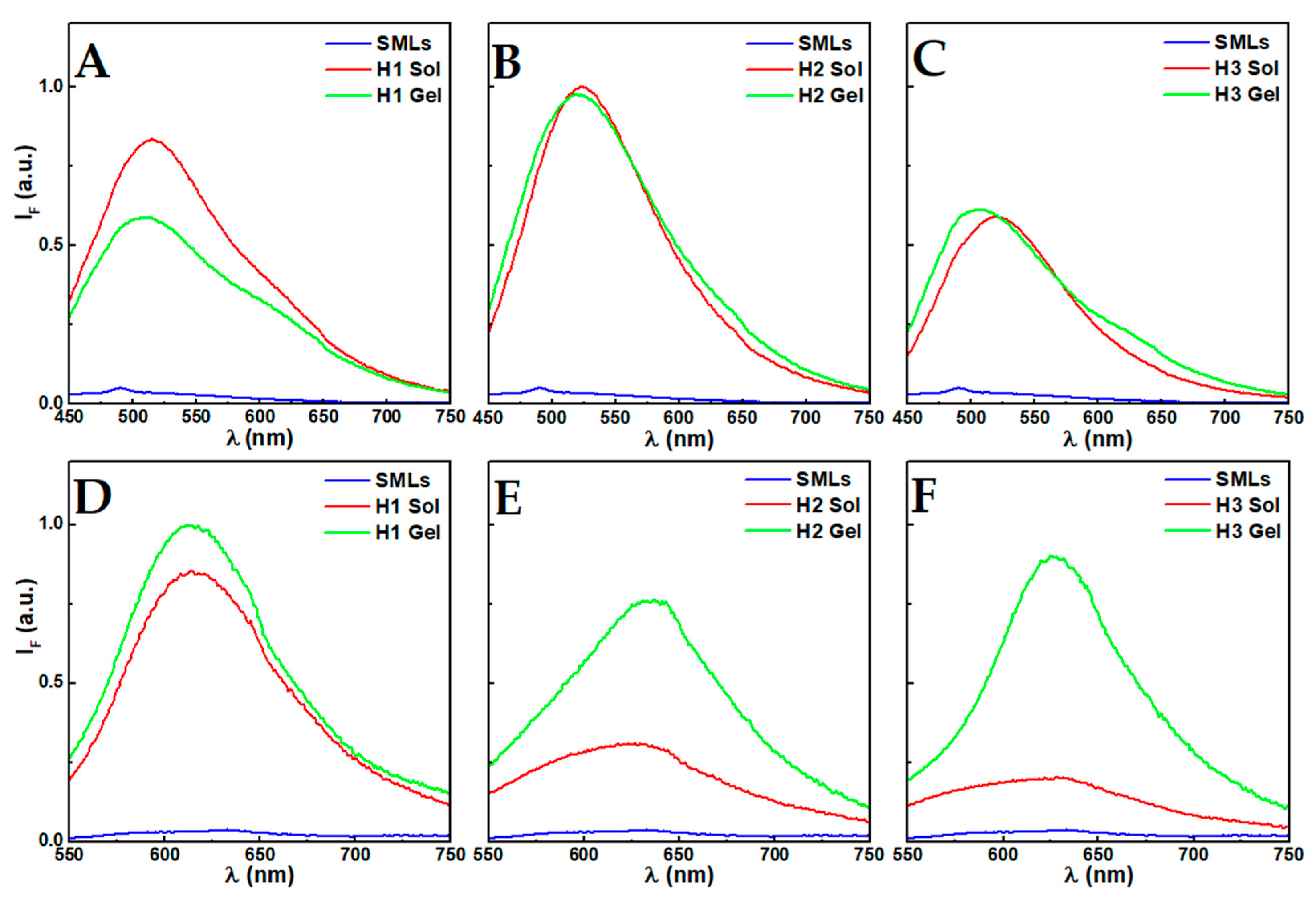Magnetoliposomes Incorporated in Peptide-Based Hydrogels: Towards Development of Magnetolipogels
Abstract
1. Introduction
2. Materials and Methods
2.1. Preparation of Manganese Ferrite Nanoparticles
2.2. Preparation of Magnetoliposomes
2.3. Spectroscopic and Characterization Measurements
2.4. Incorporation of the Magnetoliposomes in Hydrogels
3. Results and Discussion
4. Conclusions
Supplementary Materials
Author Contributions
Funding
Conflicts of Interest
References
- Gogoi, M.; Jaiswal, M.K.; Banerjee, R.; Bahadur, D. Magnetic liposomes and hydrogels towards cancer therapy. In Magnetic Nanoparticles: From Fabrication to Clinical Applications, 1st ed.; Thanh, N.T.K., Ed.; CRC Press: Boca Raton, FL, USA, 2012; pp. 479–487. [Google Scholar]
- Grijalvo, S.; Mayr, J.; Eritja, R.; Díaz, D. Biodegradable liposome-encapsulated hydrogels for biomedical applications: A marriage of convenience. Biomater. Sci. 2016, 4, 555–574. [Google Scholar] [CrossRef]
- Hanuš, J.; Ullrich, M.; Dohnal, J.; Singh, M.; Štěpánek, F. Remotely controlled diffusion from magnetic liposome microgels. Langmuir 2013, 29, 4381–4387. [Google Scholar] [CrossRef] [PubMed]
- De Cogan, F.; Booth, A.; Gough, J.; Webb, S. Spatially controlled apoptosis induced by released nickel(ii) within a magnetically responsive nanostructured biomaterial. Soft Matter 2013, 9, 2245. [Google Scholar] [CrossRef]
- Mart, R.; Liem, K.; Webb, S. Magnetically-controlled release from hydrogel-supported vesicle assemblies. Chem. Commun. 2009, 17, 2287. [Google Scholar] [CrossRef] [PubMed]
- Reimhult, E. Nanoparticle-triggered release from lipid membrane vesicles. New Biotechnol. 2015, 32, 665–672. [Google Scholar] [CrossRef]
- Leng, F.; Gough, J.; Webb, S. Enhancing cell culture in magnetic vesicle gels. MRS Proc. 2010, 1272. [Google Scholar] [CrossRef]
- Veloso, S.R.S.; Martins, J.A.; Hilliou, L.; Amorim, C.O.; Amaral, V.S.; Almeida, B.G.; Jervis, P.J.; Moreira, R.; Pereira, D.M.; Coutinho, P.J.G.; et al. Dehydropeptide-based plasmonic magnetogels: A supramolecular composite nanosystem for multimodal cancer therapy. J. Mater. Chem. B 2020, 8, 45–64. [Google Scholar] [CrossRef]
- Veloso, S.R.S.; Magalhães, C.A.B.; Rodrigues, A.R.O.; Vilaça, H.; Queiroz, M.J.R.P.; Martins, J.A.; Coutinho, P.J.G.; Ferreira, P.M.T.; Castanheira, E.M.S. Novel dehydropeptide-based magnetogels containing manganese ferrite nanoparticles as antitumor drug nanocarriers. Phys. Chem. Chem. Phys. 2019, 21, 10377–10390. [Google Scholar] [CrossRef] [PubMed]
- Vilaça, H.; Pereira, G.; Castro, T.G.; Hermenegildo, B.F.; Shi, J.; Faria, T.Q.; Micaêlo, N.; Brito, R.M.N.; Xu, B.; Castanheira, E.M.S.; et al. New self-assembled supramolecular hydrogels based on dehydropeptides. J. Mater. Chem. B 2015, 3, 6355–6367. [Google Scholar] [CrossRef]
- Vilaça, H.; Castro, T.; Costa, F.M.G.; Melle-Franco, M.; Hilliou, L.; Hamley, I.W.; Castanheira, E.M.S.; Martins, J.A.; Ferreira, P.M.T. Self-assembled RGD dehydropeptide hydrogels for drug delivery applications. J. Mater. Chem. B 2017, 5, 8607–8617. [Google Scholar] [CrossRef]
- Rodrigues, A.R.O.; Ramos, J.M.F.; Gomes, I.T.; Almeida, B.G.; Araújo, J.P.; Queiroz, M.J.R.P.; Coutinho, P.J.G.; Castanheira, E.M.S. Magnetoliposomes based on manganese ferrite nanoparticles as nanocarriers for antitumor drugs. RSC Adv. 2016, 6, 17302–17313. [Google Scholar] [CrossRef]
- Rodrigues, A.R.O.; Almeida, B.G.; Rodrigues, J.M.; Queiroz, M.J.R.P.; Calhelha, R.C.; Ferreira, I.C.F.R.; Pires, A.; Pereira, A.M.; Araújo, J.P.; Coutinho, P.J.G.; et al. Magnetoliposomes as carriers for promising antitumor thieno[3,2-b]pyridin-7-arylamines: Photophysical and biological studies. RSC Adv. 2017, 7, 15352–15361. [Google Scholar] [CrossRef]
- Cardoso, B.D.; Rio, I.S.R.; Rodrigues, A.R.O.; Fernandes, F.C.T.; Almeida, B.G.; Pires, A.; Pereira, A.M.; Araújo, J.P.; Castanheira, E.M.S.; Coutinho, P.J.G. Magnetoliposomes containing magnesium ferrite nanoparticles as nanocarriers for the model drug curcumin. R. Soc. Open Sci. 2018, 5, 181017. [Google Scholar] [CrossRef] [PubMed]
- Pereira, D.S.M.; Cardoso, B.D.; Rodrigues, A.R.O.; Amorim, C.O.; Amaral, V.S.; Almeida, B.G.; Queiroz, M.J.R.P.; Martinho, O.; Baltazar, F.; Calhelha, R.C.; et al. Magnetoliposomes containing calcium ferrite nanoparticles for applications in breast cancer therapy. Pharmaceutics 2019, 11, 477. [Google Scholar] [CrossRef] [PubMed]
- Rodrigues, A.R.O.; Matos, J.O.G.; Dias, A.M.N.; Almeida, B.G.; Pires, A.; Pereira, A.M.; Araújo, J.P.; Queiroz, M.J.R.P.; Castanheira, E.M.S.; Coutinho, P.J.G. Development of multifunctional liposomes containing magnetic/plasmonic MnFe2O4/Au core/shell nanoparticles. Pharmaceutics 2018, 11, 10. [Google Scholar] [CrossRef] [PubMed]
- Rodrigues, A.R.O.; Mendes, P.M.F.; Silva, P.M.L.; Machado, V.A.; Almeida, B.G.; Araújo, J.P.; Queiroz, M.J.R.P.; Castanheira, E.M.S.; Coutinho, P.J.G. Solid and aqueous magnetoliposomes as nanocarriers for a new potential drug active against breast cancer. Colloids Surf. B 2017, 158, 460–468. [Google Scholar] [CrossRef]
- Khopde, S.; Indira Priyadarsini, K.; Palit, D.; Mukherjee, T. Effect of solvent on the excited-state photophysical properties of curcumin. Photochem. Photobiol. 2007, 72, 625–631. [Google Scholar] [CrossRef]
- Manolova, Y.; Deneva, V.; Antonov, L.; Drakalska, E.; Momekova, D.; Lambov, N. The effect of the water on the curcumin tautomerism: A quantitative approach. Spectrochim. Acta Part A 2014, 132, 815–820. [Google Scholar] [CrossRef]
- Priyadarsini, K. The chemistry of curcumin: From extraction to therapeutic agent. Molecules 2014, 19, 20091–20112. [Google Scholar] [CrossRef]
- Cardoso, B.D.; Rodrigues, A.R.O.; Almeida, B.G.; Amorim, C.O.; Amaral, V.S.; Castanheira, E.M.S.; Coutinho, P.J.G. Stealth Magnetoliposomes based on calcium-substituted magnesium ferrite nanoparticles for curcumin transport and release. Int. J. Mol. Sci. 2020, 21, 3641. [Google Scholar] [CrossRef]
- Valeur, B. Molecular fluorescence—Principles and Applications, 1st ed.; Wiley-VCH: Weinheim, Germany, 2001. [Google Scholar]
- Alsop, R.; Dhaliwal, A.; Rheinstädter, M. Curcumin protects membranes through a carpet or insertion model depending on hydration. Langmuir 2017, 33, 8516–8524. [Google Scholar] [CrossRef] [PubMed]
- Greenspan, P.; Fowler, S. Spectrofluorometric studies of the lipid probe Nile Red. J. Lipid Res. 1985, 26, 781–789. [Google Scholar] [PubMed]
- Krishnamoorthy, I.G. Probing the link between proton transport and water content in lipid membranes. J. Phys. Chem. B 2001, 105, 1484–1488. [Google Scholar]
- Coutinho, P.J.G.; Castanheira, E.M.S.; Rei, M.C.; Oliveira, M.E.C.D.R. Nile Red and DCM fluorescence anisotropy studies in C12E7/DPPC mixed systems. J. Phys. Chem. B 2002, 106, 12841–12846. [Google Scholar] [CrossRef]
- Hungerford, G.; Castanheira, E.M.S.; Real Oliveira, M.E.C.D.; Miguel, M.G.; Burrows, H. Monitoring ternary systems of C12E5/water/tetradecane via the fluorescence of solvato-chromic probes. J. Phys. Chem. B 2002, 106, 4061–4069. [Google Scholar] [CrossRef]
- Swain, J.; Mishra, A. Nile red fluorescence for quantitative monitoring of micropolarity and microviscosity of pluronic F127 in aqueous media. Photochem. Photobiol. Sci. 2016, 15, 1400–1407. [Google Scholar] [CrossRef]
- Swain, J.; Mishra, J.; Ghosh, G.; Mishra, A. Quantification of micropolarity and microviscosity of aggregation and salt-induced gelation of sodium deoxycholate (NaDC) using Nile red fluorescence. Photochem. Photobiol. Sci. 2019, 18, 2773–2781. [Google Scholar] [CrossRef]
- Saxena, S.; Pradeep, A.; Jayakannan, M. Enzyme-responsive theranostic FRET probe based on l-aspartic amphiphilic polyester nanoassemblies for intracellular bioimaging in cancer cells. ACS Appl. Biol. Mater. 2019, 2, 5245–5262. [Google Scholar] [CrossRef]
- El Khoury, E.; Patra, D. Length of hydrocarbon chain influences location of curcumin in liposomes: Curcumin as a molecular probe to study ethanol induced interdigitation of liposomes. J. Photochem. Photobiol. B Biol. 2016, 158, 49–54. [Google Scholar] [CrossRef]
- Cardoso, A.; Mears, L.; Cattoz, B.; Griffiths, P.; Schweins, R.; Adams, D. Linking micellar structures to hydrogelation for salt-triggered dipeptide gelators. Soft Matter 2016, 12, 3612–3621. [Google Scholar] [CrossRef]
- Moussa, Z.; Chebl, M.; Patra, D. Fluorescence of tautomeric forms of curcumin in different pH and biosurfactant rhamnolipids systems: Application towards on-off ratiometric fluorescence temperature sensing. J. Photochem. Photobiol. B Biol. 2017, 173, 307–317. [Google Scholar] [CrossRef] [PubMed]
- Lee, W.; Loo, C.; Bebawy, M.; Luk, F.; Mason, R.; Rohanizadeh, R. Curcumin and its derivatives: Their application in neuropharmacology and neuroscience in the 21st century. Curr. Neuropharmacol. 2013, 11, 338–378. [Google Scholar] [CrossRef] [PubMed]
- Priyadarsini, K. Photophysics, photochemistry and photobiology of curcumin: Studies from organic solutions, bio-mimetics and living cells. J. Photochem. Photobiol. C Photochem. Rev. 2009, 10, 81–95. [Google Scholar] [CrossRef]
- Ingolfsson, H.I.; Koeppe, R.E.; Andersen, O.S. Curcumin is a modulator of bilayer material properties. Biochemistry 2007, 46, 10384–10391. [Google Scholar] [CrossRef]
- Hung, W.-C.; Chen, F.-Y.; Lee, C.-C.; Sun, Y.; Lee, M.-T.; Huang, H.W. Membrane-thinning effect of curcumin. Biophys. J. 2008, 94, 4331–4338. [Google Scholar] [CrossRef] [PubMed]
- Barry, J.; Fritz, M.; Brender, J.R.; Smith, P.E.; Lee, D.K.; Ramamoorthy, A. Determining the effects of lipophilic drugs on membrane structure by solid-state NMR spectroscopy: The case of the antioxidant curcumin. J. Am. Chem. Soc. 2009, 131, 4490–4498. [Google Scholar] [CrossRef]
- Leite, N.B.; Martins, D.B.; Fazani, V.E.; Vieira, M.R.; Dos Santos Cabrera, M.P. Cholesterol modulates curcumin partitioning and membrane effects. Biochim. Biophys. Acta Biomembr. 2018, 1860, 2320–2328. [Google Scholar] [CrossRef]






| Size ± SD (nm) | PDI ± SD | Zeta Potential ± SD (mV) | ||||
|---|---|---|---|---|---|---|
| After Preparation | 1 Week After | After Preparation | 1 Week After | After Preparation | 1 Week After | |
| AMLs | 113.5 ± 10 | 98.7 ± 17 | 0.23± 0.04 | 0.22 ± 0.08 | −15.3 ± 2 | −16.1 ± 4 |
| SMLs | 156.3 ± 16 | 132.2 ± 21 | 0.25 ± 0.03 | 0.21 ± 0.07 | −21.4 ± 4 | −19.7 ± 3 |
| System | MLs | H1 Sol | H1 Gel | H2 Sol | H2 Gel | H3 Sol | H3 Gel |
|---|---|---|---|---|---|---|---|
| AMLs | 0.20 | 0.17 | 0.26 | 0.27 | 0.28 | 0.22 | 0.26 |
| SMLs | 0.06 | 0.22 | 0.24 | 0.16 | 0.25 | 0.15 | 0.26 |
© 2020 by the authors. Licensee MDPI, Basel, Switzerland. This article is an open access article distributed under the terms and conditions of the Creative Commons Attribution (CC BY) license (http://creativecommons.org/licenses/by/4.0/).
Share and Cite
Veloso, S.R.S.; Andrade, R.G.D.; Ribeiro, B.C.; Fernandes, A.V.F.; Rodrigues, A.R.O.; Martins, J.A.; Ferreira, P.M.T.; Coutinho, P.J.G.; Castanheira, E.M.S. Magnetoliposomes Incorporated in Peptide-Based Hydrogels: Towards Development of Magnetolipogels. Nanomaterials 2020, 10, 1702. https://doi.org/10.3390/nano10091702
Veloso SRS, Andrade RGD, Ribeiro BC, Fernandes AVF, Rodrigues ARO, Martins JA, Ferreira PMT, Coutinho PJG, Castanheira EMS. Magnetoliposomes Incorporated in Peptide-Based Hydrogels: Towards Development of Magnetolipogels. Nanomaterials. 2020; 10(9):1702. https://doi.org/10.3390/nano10091702
Chicago/Turabian StyleVeloso, Sérgio R. S., Raquel G. D. Andrade, Beatriz C. Ribeiro, André V. F. Fernandes, A. Rita O. Rodrigues, J. A. Martins, Paula M. T. Ferreira, Paulo J. G. Coutinho, and Elisabete M. S. Castanheira. 2020. "Magnetoliposomes Incorporated in Peptide-Based Hydrogels: Towards Development of Magnetolipogels" Nanomaterials 10, no. 9: 1702. https://doi.org/10.3390/nano10091702
APA StyleVeloso, S. R. S., Andrade, R. G. D., Ribeiro, B. C., Fernandes, A. V. F., Rodrigues, A. R. O., Martins, J. A., Ferreira, P. M. T., Coutinho, P. J. G., & Castanheira, E. M. S. (2020). Magnetoliposomes Incorporated in Peptide-Based Hydrogels: Towards Development of Magnetolipogels. Nanomaterials, 10(9), 1702. https://doi.org/10.3390/nano10091702






